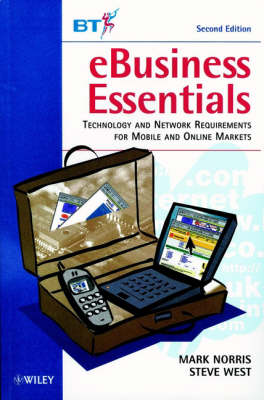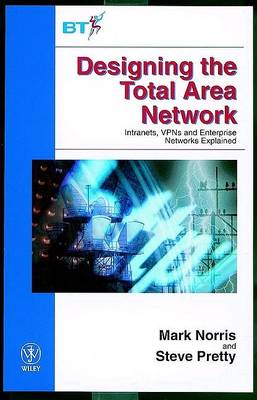Wiley-BT
4 total works
eBusiness is growing rapidly and new issues are emerging in this global and real-time activity. This new edition to the hugely successful eBusiness Essentials explores the increasingly important area of mobile data access. In addition, it shows how eBusiness is evolving and how technology can be progressively used to build more sophisticated solutions. Balancing its technical depth with a clear and practical analysis of market models it enables the reader to deploy the available and emerging technology effectively and appropriately.
In addition to the established yet equally important features such as security, payment and trust, supply chain integration and customer to supplier trade it includes: - mBusiness covering key issues such as roving and roaming access and the technologies GPRS, UMTS and WAP - Help for readers to formulate their own eBusiness strategy by drawing out some general principles - Virtual mobile network operators: data extensions to the mobile switch, home and visitor location - Analysis and real world examples of mobile services - The technical options, impact, integration, mechanics and implications of evolving eBusiness Primarily aimed at planners, engineers, managers and developers in the IT, multimedia and on-line industries. Recommended reading for students in computer science electrical & electronic engineering, IT and telecommunications.
In addition to the established yet equally important features such as security, payment and trust, supply chain integration and customer to supplier trade it includes: - mBusiness covering key issues such as roving and roaming access and the technologies GPRS, UMTS and WAP - Help for readers to formulate their own eBusiness strategy by drawing out some general principles - Virtual mobile network operators: data extensions to the mobile switch, home and visitor location - Analysis and real world examples of mobile services - The technical options, impact, integration, mechanics and implications of evolving eBusiness Primarily aimed at planners, engineers, managers and developers in the IT, multimedia and on-line industries. Recommended reading for students in computer science electrical & electronic engineering, IT and telecommunications.
Designing the Total Area Network – Intranets, VPNs and Enterprise Networks Explained
by Mark Norris and Steve Pretty
Published 7 December 1999
Tackles the many issues surrounding one of the most important assets in any company: its network. Modern networks need to be fast and effective to meet the ever-increasing need to for more information and faster communication. This text offers a clear and concise presentation of the key issues for those involved in the purchase, management, planning and implementation of communication networks. It provides the broad technical understanding required to ask the right questions, set viable plans and avoid expensive investment and deployment mistakes. Explains effective and practical design techniques for communication networks Advises how to avoid the common pitfalls associated with setting up and running a network Focuses on the techniques for planning and assembling network technology Presents numerous real examples This is essential reading for network designers and will be recommended reading for students in computer science, electrical and electronic engineering and telecommunications courses. Norris and Pretty tackle the many issues surrounding the design of one of the most important communication infrastructures in a company.
The enterprise network needs to be fast and effective to meet an ever increasing demand for more information and communication. It provides broad technical understanding to aid those involved in the purchase, management, planning and implementation of enterprise networks. Effective and practical design techniques are explained in detail and are illustrated with real examples. It also discusses the associated pitfalls which often occur to show the reader what not to do when setting up a network.
The enterprise network needs to be fast and effective to meet an ever increasing demand for more information and communication. It provides broad technical understanding to aid those involved in the purchase, management, planning and implementation of enterprise networks. Effective and practical design techniques are explained in detail and are illustrated with real examples. It also discusses the associated pitfalls which often occur to show the reader what not to do when setting up a network.
Total Area Networking ATM,IP, Frame Relay and SMDS Explained Second Edition John Atkins and Mark Norris BT, UK Total Area Networking explains how high-speed communications allow local facilities to become part of a more global network. This concept is the essential basis for super-connectivity, when the user sees a distributed set of network-based resources as one. This fully updated second edition of the highly successful Total Area Networking has been extended to include IP networks and now covers both network technology and its applications. It illustrates the practical implementation of a total area network using the principles developed for Intelligent Networks, Intranets and Virtual Private Networks. Main topics include ATM (Asynchronous Transfer Mode), IP (Internet Protocol), Frame Relay and SMDS (Switched Multi-magabit Data Service). Covers the whole spectrum of communications technology, from theory to implementation. Provides a clear understanding of what new technology can do and how it can best be deployed. Allows the non-expert to question both accurately and indepth.
Essential reading for a wide ranging audience, including professionals involved in the planning and implementation of information systems, undergraduate and postgraduate students of computer science, electrical engineering and telecommunications.
Essential reading for a wide ranging audience, including professionals involved in the planning and implementation of information systems, undergraduate and postgraduate students of computer science, electrical engineering and telecommunications.
This comprehensive text provides a clear and concise explanation of communications technology and the key telecommunications and computing concepts. Written in an accessible style, considerable attention has been paid to making the topics comprehensible and to convey understanding, not just data. Enables the reader to extend their knowledge of communications technology Details the ideas that are both current and evolving in communication systems Allows the non-expert to question both accurately and in-depth whilst providing context for the specialist and detail for the generalist Offers advice to the network and telecommunications specialist This is essential reading for anyone who needs to appreciate the breadth of communications technology. It is also aimed at the project manager, system analyst and software designer and will be a useful text for final year and postgraduate students on computer science, electrical engineering, IT and telecommunications courses..


